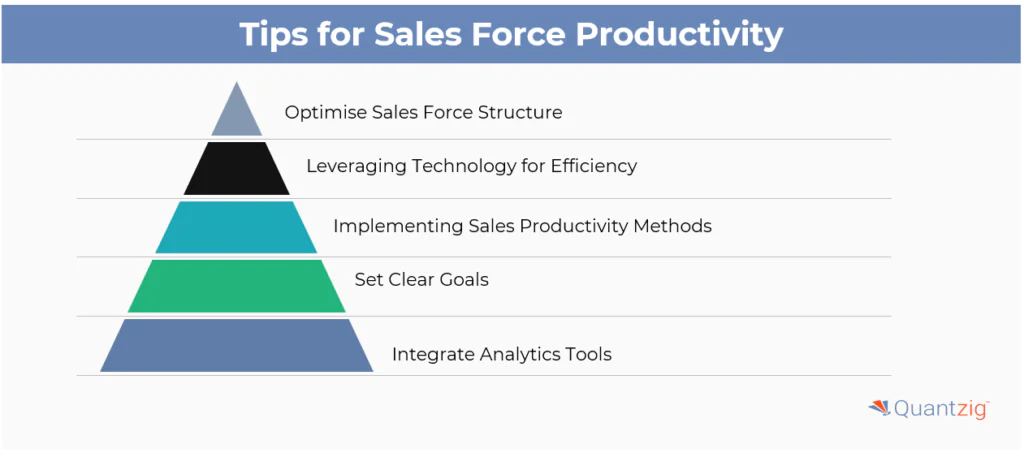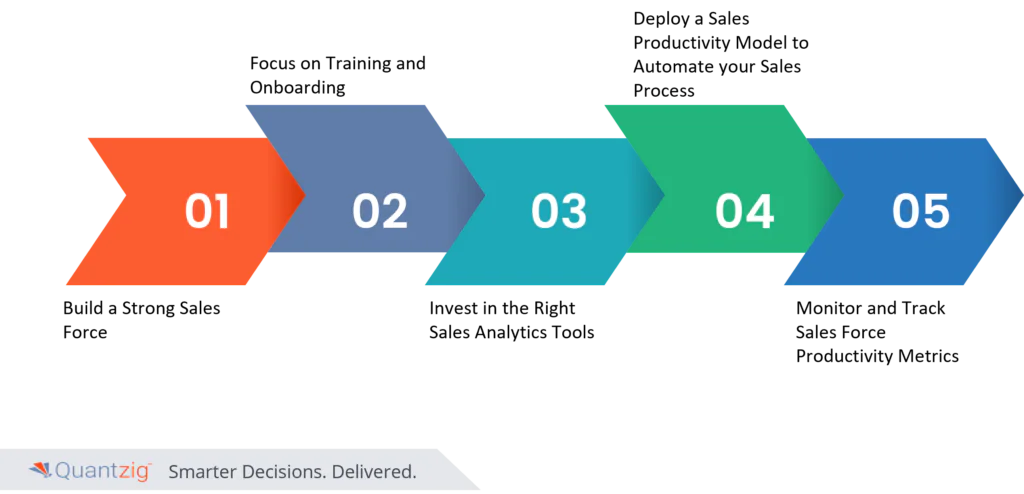Written by: Medha Banerjee
Table of Contents
Introduction to productivity in sales
Unlocking the true potential of sales data is unquestionably one of the top ways to make a breakthrough in sales force productivity, returns, business growth, and market position, but this is easier said than done. Leading enterprises often struggle when it comes to structuring and redesigning their teams. Challenges such as an inefficient workforce, fragmented sales channels, talent gap, and high attrition rates make sales force productivity initiatives tougher to execute in today’s business scenario.
Here’s a fable that rightly explains the importance of adopting a modern approach to improving productivity- Tim McCarthy returned home scowling. The reason- the stakeholders wanted another 11% increase in sales from his team this year. Gone are the days when he could simply announce a 10% increase in sales and divide the targets among the sales reps from each region or product category and wait for them to deliver it. Today, the procurement teams of Tim’s customers use advanced algorithms and analytics tools to identify and collaborate with vendors for routine buys; the result obtained often exceeded manual findings making it the most sought-after approach. For more complex processes, his customers wanted customized end-to-end solutions.
Considering the complexities involved, it wasn’t an easy task, no matter how hard he/she tried to close all the deals. What’s needed at times like these, is a team of highly skilled industry experts that possess the knowledge of market know-how and the right skills to drive forward the efforts. The fact was—he knew he’d have to face it sooner or later. Nothing about improving sales force productivity to achieve the new target was as simple or predictable as it used to be. 11% growth? He wasn’t even sure if he was on the right track.
We’re sure it sounds familiar, it’s because sales managers often face such situations in real life. Over the past few years, we’ve worked with clients facing similar challenges, and this has helped us build better sales strategies to help them thrive in a dynamic environment.
Book a demo to experience the meaningful insights we derive from data through our analytical tools and platform capabilities. Schedule a demo today!
Request a Free DemoWhat is Sales force productivity?

Sales force productivity is the efficiency and effectiveness with which sales reps in B2B organizations achieve sales targets. It involves optimizing every stage of the sales cycle through sales training and digital sales training. By streamlining the sales journey, sales and marketing alignment becomes more cohesive, allowing each salesperson to maximize sales activity and improve efficiency maximization.
Enhanced client meetings and proper time management result in higher customer satisfaction and stronger customer relationships. As a result, sales reps and B2B organizations gain a competitive advantage in their industry.
Tips on How to Improve sales productivity metrics

In today’s economic environment, companies grapple with a common challenge: increasing sales productivity in the face of economic uncertainties. The push to achieve higher revenue targets following crises intensifies this struggle. Many businesses are expanding their sales reps teams to pursue ambitious goals as they work to recoup lost sales and revenue. However, a crucial gap arises when processes, technology adoption, and analytics tools aren’t scaled quickly enough. As a result, B2B organizations experience a notable decline in sales productivity and fall short of their sales goals. This often leads to a downturn in the sales cycle and hinders the overall sales journey of the salesperson.
Moreover, an effective focus on sales training, including digital sales training, is essential to align sales and marketing efforts. Without proper emphasis on optimizing sales activity and efficiency maximization, organizations risk falling behind in achieving meaningful client meetings, productive time management, and high levels of customer satisfaction. Ultimately, neglecting these aspects can negatively impact customer relationships and the business’s competitive advantage.
1. Optimize Sales Force Structure:
A pivotal step in improving sales force productivity is optimizing the structure. Companies must align their sales force with the current market dynamics and customer expectations. This involves evaluating the size of the team, assessing territories, and ensuring a balanced workload. An effective structure enhances efficiency and enables sales reps to focus on high-priority tasks, ultimately driving productivity.
Example: Implementing a territory-based structure ensures that sales reps concentrate on specific regions, fostering better understanding and engagement with local customers.
2. Leverage Technology for Efficiency:
Embracing technology is paramount in the quest to enhance sales force productivity. Equip sales teams with advanced tools and platforms that streamline processes, automate routine tasks, and provide valuable insights. Customer Relationship Management (CRM) systems, sales automation tools, and data analytics platforms empower sales reps with the information and resources needed for effective decision-making and targeted selling efforts.
3. Implement Sales Productivity Methods:
Explore proven methods to boost sales productivity. This involves providing ongoing training to sales teams, incorporating methodologies that align with customer preferences, and fostering a culture of continuous improvement. By refining selling techniques and staying abreast of industry trends, sales professionals can adapt swiftly to changing market conditions, thereby maintaining high levels of productivity.
4. Set Clear Productivity Goals:
Establishing clear and measurable productivity goals is essential. Define key performance indicators (KPIs) that align with overall business objectives. These KPIs may include conversion rates, customer acquisition costs, and sales cycle duration. Regularly monitor and assess performance against these goals, adjusting strategies as needed to ensure continuous improvement in sales force productivity.
5. Integrate Analytics Tools:
Harness the power of analytics to gain actionable insights into sales performance. Implement analytics tools that provide comprehensive data on customer behavior, market trends, and team effectiveness. Analyzing this data enables organizations to make informed decisions, identify areas for improvement, and optimize sales strategies for greater efficiency.
In navigating economic challenges, businesses must recognize the interconnectedness of sales force productivity, technology adoption, and strategic analytics. By aligning these components and implementing targeted strategies, companies can overcome current hurdles, regain lost sales, and position themselves for sustained success in the evolving market landscape.
Experience the advantages firsthand by testing a customized complimentary pilot designed to address your specific requirements. Pilot studies are non-committal in nature.
Request a free pilot
How To Increase Sales Force Productivity?
The traditional approach adopted by most teams to improve sales force productivity involved analyzing historical sales data sets to gauge the number of new sales executives that could be hired given the market potential and the ramp-up time required to meet the set target. Today, successful businesses follow a more scientific, analytics-backed approach to improving sales performance- one that focuses on improving sales force productivity using advanced analytics. On the contrary, they have learned to leverage five levers that make productivity increase both predictable and controllable.
We bring to you five fail proof strategies that’ll help you boost sales force productivity & improve revenue acquisition.

1 Build a Strong Sales Force
How you go about building a strong sales force defines the failure or success of your sales force productivity initiatives. To meet your business goals, it’s crucial to identify and deploy not just the right talent, but identify the right support, marketing channels, and resources that can help your sales teams achieve their targets.
2 Focus on Training and Onboarding
The basic principle for building a highly-driven, knowledgeable sales team is good onboarding and training. Investing in the right training and onboarding tools is crucial since it leaves a huge impact on the future productivity of your sales force.
3 Invest in the Right Sales Analytics Tools
We’re sure every organization has budgetary restrictions when it comes to investing in such tools, but its crucial to make sure you aren’t saving up at the expense of improving sales force productivity. Gathering sales data from disparate sources and analyzing them using traditional approaches can be time-consuming. Investing in the right sales analytics tools can help you achieve a faster time to insight, which in turn, can help you uncover opportunities for improvement.
4 Deploy a Sales Productivity Model to Automate your Sales Process
One most sought after way to boost your sales productivity is to give your reps more time to achieve their targets. And to do so, businesses must automate sales processes, this way they eliminate redundant tasks while providing more time for sales reps to focus on their core selling activities.
5 Monitor and Track Sales Force Productivity Metrics
Sales force productivity metrics including win rate, sales cycle length, conversation rates, and call rate can help you evaluate the productivity of your team. Evaluating outcomes using these metrics is crucial since it defines the success of your sales force productivity strategies, helping you take immediate actions to address key problem areas. Also, the use of advanced sales analytics dashboards to monitor these metrics have helped businesses visualize trends and gain valuable insights to enhance their sales force productivity initiatives.
Get started with your complimentary trial today and delve into our platform without any obligations. Explore our wide range of customized, consumption driven analytical solutions services built across the analytical maturity levels.
Start your free trialThe Way Forward: improving sales productivity
In conclusion, the journey to amplify sales force productivity is multifaceted, demanding a blend of coaching, motivation, and time management. Successful organizations foster collaboration and communication, key pillars that support a robust sales pipeline. Prospecting and closing are enhanced when backed by strategic forecasting and a strong coaching culture. A productive salesforce’s is the lifeblood of any thriving organization, and harnessing the full capabilities of a salesforce CRM system is critical for boosting salesforce productivity.
Integrating software solutions, particularly a sales cloud, catalyzes the sales force’s productivity. By deploying force automation, companies can streamline operations and elevate their sales forces’ effectiveness. The objective is to increase effectiveness, which is paramount in today’s competitive market. Each step in this process, from the initial customer engagement to the final handshake, is a testament to a well-oiled sales machine, driven by technology and human insight.
Conclusion
In conclusion, implementing the identified strategies is pivotal for organizations navigating economic challenges and striving to enhance sales force productivity. The optimization of sales force structure ensures a strategic alignment with market dynamics, fostering efficiency and targeted engagement. Leveraging technology empowers teams with tools that automate tasks, streamline processes, and provide valuable insights for informed decision-making.
Proven productivity methods, coupled with ongoing training, instill adaptability and continuous improvement within the sales force. Clear goal setting, centered around measurable key performance indicators, establishes a roadmap for success. Finally, the integration of analytics tools enables data-driven decision-making, offering valuable insights into customer behavior and market trends. By adopting these strategies cohesively, businesses can not only overcome economic challenges but also position themselves for sustained success in an ever-evolving sales landscape.



